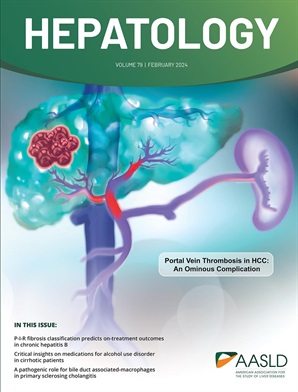Refinement of histologic subtypes and identification of biomarkers linked to unfavorable prognosis in cholangiocarcinoma: The ENSCCA registries’ framework for digital twin advancement
IF 12.9
1区 医学
Q1 GASTROENTEROLOGY & HEPATOLOGY
引用次数: 0
Abstract
Background & Aims: Cholangiocarcinoma (CCA) displays remarkable anatomical and histological heterogeneity. Besides diagnosis confirmation, histology currently does not have a major role in the management of CCA. We aimed to study the clinical relevance of histological heterogeneity of CCA and putative tissue biomarkers by creating a multicentric digitalized European CCA Histology Registry. Approach & Results: Nine referral centers, participating in the International Cholangiocarcinoma clinical registry, shared samples and data from 293 patients. Histological and immunohistochemistry stains (n=10) were performed. Computed tomography (CT) scans (n=112 cases) were analyzed by morphological and radiomics techniques. A selection of cases (n=18) was processed for spatial transcriptomics analysis. No significant differences in 5-year overall survival (OS) were found in perihilar CCA vs intrahepatic (i) CCA, and in Small Bile Duct (SBD) vs Large Bile Duct (LBD) iCCA. When cases were classified by periodic acid of Schiff (PAS) positivity (mucin content), PAS胆管癌组织学亚型的细化和与不良预后相关的生物标志物的鉴定:ENSCCA登记处的数字双胞胎进展框架
背景,目的:胆管癌(CCA)具有明显的解剖和组织学异质性。除了诊断证实外,组织学目前在CCA的治疗中没有主要作用。我们旨在通过创建一个多中心数字化的欧洲CCA组织学登记处,研究CCA的组织学异质性和假定的组织生物标志物的临床相关性。的方法,结果:参与国际胆管癌临床登记的9个转诊中心共享了293例患者的样本和数据。进行组织学和免疫组化染色(n=10)。计算机断层扫描(CT) (n=112例)通过形态学和放射组学技术进行分析。选取18例病例进行空间转录组学分析。肝门周围CCA与肝内CCA,小胆管(SBD)与大胆管(LBD) iCCA的5年总生存率(OS)无显著差异。当以周期性希夫酸(PAS)阳性(粘蛋白含量)分类时,PASHIGH LBD iCCA的5年OS明显低于PASLOW iCCA。多变量Cox回归发现PASHIGH LBD iCCA表型是较差OS的独立预测因子。PASHIGH LBD iCCA亚型在空间转录组学和免疫组织化学上表现出特定的分子特征;CT扫描和血清学可准确区分PASHIGH LBD iCCA表型。结论:我们的数据强调了识别CCA中具有显著患病率的形态学亚类作为风险分层和预后工具的重要性。欧洲CCA组织学注册代表了一个整合数字病理学与临床、放射学和分子信息的有价值的平台,作为数字双胞胎进步的框架。
本文章由计算机程序翻译,如有差异,请以英文原文为准。
求助全文
约1分钟内获得全文
求助全文
来源期刊

Hepatology
医学-胃肠肝病学
CiteScore
27.50
自引率
3.70%
发文量
609
审稿时长
1 months
期刊介绍:
HEPATOLOGY is recognized as the leading publication in the field of liver disease. It features original, peer-reviewed articles covering various aspects of liver structure, function, and disease. The journal's distinguished Editorial Board carefully selects the best articles each month, focusing on topics including immunology, chronic hepatitis, viral hepatitis, cirrhosis, genetic and metabolic liver diseases, liver cancer, and drug metabolism.
 求助内容:
求助内容: 应助结果提醒方式:
应助结果提醒方式:


